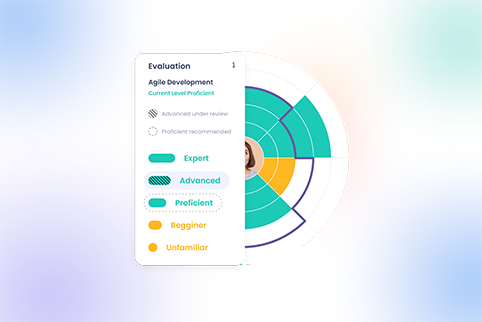
The role and purpose of Human Resources are undergoing a profound transformation. From rapid and disruptive technological breakthroughs to dynamic workforce demographics and evolving employee expectations, a plethora of factors have seen HR shift from a primarily administrative function to a more strategic role in organizational success — and this is what we refer to as HR transformation.
This paradigm shift isn’t only about modernization or digitalization. It’s an (almost) complete reimagining of how businesses attract, develop, and manage their most important asset: talent.
In this article, we explore the pivotal significance of HR transformation in today’s work landscape and explain why agility is now the name of the game. We also look at what this journey is all about and how you can start creating an HR transformation strategy for your company. Let’s dive right in!
What is HR transformation?
HR transformation is the deliberate process of re-envisioning and modernizing the role, responsibilities, and operations of the Human Resources department. It represents a strategic and multi-layered effort to eliminate any outdated practices, ineffective procedures, and the hidden costs associated with redundancies.
One of the most important aspects of HR transformation is technology, as it enables HR professionals to better align their strategic objectives and operations — from workforce planning and hiring to talent development and payroll — with evolving business needs and improve the overall employee experience.
The transformation process also sees HR moving into a more strategic position within the company, one that requires a different mindset, and, to some extent, a new set of skills when compared to the capabilities required for the current, more administrative HR role within companies.
This shift or natural evolution of HR is also reflected in the titles from this field, with ‘People and Culture’, ‘People Analytics Manager’, or ‘Chief People Officer’ becoming increasingly common and highlighting the importance of more human- and data-centric approaches.
Why is HR transformation needed?
Rapid technological progress and automation, as well as the changes they bring about, are perhaps the main drivers behind HR transformation. Without this shift, both HR and the workforces they build and support will be unable to stay ahead of future trends and the ongoing changes occurring at a pace few can keep up with.
Market expectations also reflect this and impact business decisions, with modern-day consumers demanding instant and seamless access to products and services. To deliver, companies need to adapt both their processes and employees, and this means HR is no exception.
Another important factor driving HR transformation is represented by skills and skills-based approaches, which are taking the spotlight and becoming critical in almost any HR and talent management process.
Departmental silos and fixed traditional job roles will not survive in this new environment and need to make space for solutions like skills-based talent management or agile workforces, both critical for the future of work.
And, of course, there’s also the reality of top talent becoming more valuable and in-demand than ever. Attracting and retaining employees is more important but also more challenging nowadays, particularly in a tight talent market, where the balance tilts toward candidates, whose new expectations require a thoughtful and well-planned response.
Gen Z stands out in this case, as they have already developed a reputation for quickly leaving employers that fail to meet their expectations, especially those related to professional development and career growth.
But the truth is for both current and future generations in the workforce, HR can no longer rely on traditional approaches and needs to look at data-driven insights from people analytics to truly understand what people want and need and nurture higher retention rates.
What does HR transformation mean?
Having made the case for HR transformation, let’s take a closer look at what this process actually involves:
Strategic alignment
Aligning HR strategies and workforce planning with the overall business objectives is only one aspect of HR taking on a more strategic role. This is essential for ensuring that the department is focused on the right things and that its actions are driving the organization forward.
The second aspect, however, of this role transition (if we can call it that) is the increasing need for tighter collaboration between HR experts and C-level executives, one that also requires the former to develop their business acumen and improve critical thinking.
Communication is also important here, as making a case for something or talking to employees and managers is one thing. Doing the same with key stakeholders and decision-makers is another. It’s not only about understanding their needs and vision for the company but also about being able to explain the ROI of HR initiatives and present compelling evidence or data for moving in a particular direction.
Better data-driven decision making
Data is no longer an asset that only large companies, like Google or Meta, use to better understand customers and implement targeted solutions on their platforms. Data is becoming the new operating system in the workplace.
And HR needs to take advantage of this because technology-driven solutions can reveal trends or patterns that would otherwise go unnoticed. And this isn’t only limited to employee attrition risk either.
From skill gaps and performance management to succession planning and candidate suitability — literally, almost any HR process can be improved and transformed thanks to insights from data. And learning to use powerful analytics tools and extract the most relevant information will be one of the new expectations from HR departments.
Improved employee experience
Prioritizing the overall experience of employees is already a part of the HR function, and will only become more important over the next years. It’s all about looking at and improving various aspects, such as:
- work environment
- benefits and compensation
- professional development and career growth
- employee well-being
It’s also about finding a balance between meeting the specific needs of each individual and providing a fair and supportive environment, in which everyone can find their place, be themselves, and deliver their best results.
For example, hybrid or remote work policies need to be flexible. It’s great to offer everyone the possibility to come to the office and meet in person, but forcing people to do so can eventually lead to frustration — which is why employees should be involved in the decision-making process so that feel their voices heard.
Automation and Cost savings
HR transformation will see certain processes or administrative tasks become automated, reducing some of the costs associated with them. It will also enable HR specialists to focus on more strategic and complex issues, thus bringing higher value and ROI to their efforts.
During this process, you’ll also discover what works and what doesn’t. Difficult decisions will have to be made, including transitions to new platforms or online tools. And while they can be tricky and time-consuming, the long-term benefits far outweigh the initial costs of making the change.
Unlocking future readiness
One of the lessons from the pandemic was that flexibility and agility are fundamental values that can help organizations overcome disruptions and unexpected changes.
And few departments have felt it more than HR, which was in charge of coordinating hybrid or remote transitions and ensuring employees could remain engaged even in challenging conditions.
Building up on this trend, HR transformation will seek to further nurture future-ready workforces and ensure a sustainable continuity for the company. And it all starts with understanding the capabilities of your employees and addressing the current skill gaps.
To be successful in this initiative, HR professionals will need to combine effective tools, like skill matrices, with targeted L&D programs and a company culture that supports and encourages growth and knowledge sharing among people.
Optimizing remote or hybrid work environments and policies
Although companies like Google, Apple, or X (Twitter) are enforcing return-to-office policies, the truth is hybrid and remote work isn’t going anywhere. The ‘cat is already out of the bag’, as the old saying goes, in the sense that the benefits of working from home are now clear to anyone.
And as part of HR transformation initiatives, your department might need to find answers to questions like:
- How can we help employees who still seek and need face-to-face interactions with their colleagues?
- How can we design policies that are balanced and allow people to come to the office when/if they need to?
- What are the best ways/tools to gather feedback from our employees on hybrid or remote work policies?
- Are productivity paranoia or Zoom fatigue present among our workforce? If yes, how can we best address them?
Creating an HR transformation strategy
While HR transformation is by no means a simple process, developing an effective strategy in that direction starts with a few steps:
Assess the current HR function and departmental expectations
Not all companies and HR departments are equal. For some, remote work has been the default even before the pandemic. Others are still struggling to implement more tech-driven solutions.
The point is that creating an HR transformation strategy should start with a thorough understanding of the current role and challenges of HR in your organization. It will reveal the existing limitations as well as what needs to be addressed as part of the transformation process. You can then move on to the next step:
Define specific goals and clear metrics to evaluate the success of the transformation process
Establishing the new role and responsibilities of HR needs to be done in alignment with the larger business objectives and the input of key business stakeholders. It should take into account the direction of the company over the next years as well as the current and future needs of the workforce.
Like any other process, its success can only be determined when measured against the initial strategic objectives and metrics, such as:
- An increase in employee engagement, satisfaction, and retention
- Improving the quality of hire as well as recruitment duration and costs
- The impact of new HR systems, software, and tools on efficiency and performance
- HR’s measurable impact on business outcomes in its new more strategic role
- The improvement in L&D outcomes and the overall performance of employees
- The overall quality of the work environment and measurable results, such as the eNPS
To be successful in this step, bear in mind the words of HR thought leader, Josh Bersin:
The role of HR has changed, and we need to stop “building solutions” and “taking orders” and spend more time “Falling In Love With The Problem.”
Identify relevant skill gaps
Adapting to a more strategic and leadership-oriented role will require more advanced soft skills from HR and a better understanding of business processes and strategies. These gaps need to be addressed, and given their importance, coaching from higher leadership might be the fastest and most effective way to do so.
Of course, there are also technical or digital skill gaps. Implementing and learning how to use new HR tools will take time, especially when people are only familiar with more traditional or legacy systems.
The learning curve can be reduced significantly by choosing the best-fit solutions for your company and not adopting this or that tool simply because the competition is using it.
Create a step-by-step transformation plan
This plan should include a logical and easy-to-follow series of steps that will take your HR department through the transformation journey. Each step needs to be clearly outlined, have well-defined goals, and explain how or when it is okay to move to the next stage of the process.
Since the entire process will expand over a longer period of time, it will require the support and understanding of all people within the company, from employees and managers to C-level executives and business owners.
One of the main roles of HR throughout this journey is to clearly communicate to everyone how and why these changes are being made and to address any questions or concerns that emerge.
Align the current organizational culture with the HR transformation process
You cannot radically change the status of HR inside the company without also adjusting the overall organizational culture — they go hand in hand.
The easiest way to do so is to create a culture in which change and continuous learning are the new operating systems. Challenges are viewed as opportunities. Learning from trial and error is praised and encouraged.
When flexibility and cross-departmental collaboration become second nature to your employees, the new HR operations and processes can also integrate faster and bring benefits to employees and stakeholders alike.
Choose the best-fit HR software and systems for your organization
As already mentioned, the role of technology in HR transformation is critical. It’s not only about migrating from legacy systems or finding ways of integrating them with modern solutions. It’s also about identifying the tools that can bring the highest ROI to your specific department and needs.
Here, it’s good to keep an open mind. Just because something hasn’t worked for the company in the past or hasn’t worked for others, it doesn’t mean it won’t work now. This is the time to embrace new solutions, which even a few years ago weren’t available. We’re talking about:
- Internal talent marketplaces: Dynamic platforms that centralize projects, gigs, development opportunities, and even new roles — making them transparent and easily accessible for all employees.
- Skills management software: Powerful tools designed to help HR departments and people leaders gain in-depth visibility and understanding of their workforce’s skills and knowledge in order to better manage and further optimize them in time.
- Career pathing modules: These modules present employees with flexible career opportunities, that evolve together with their own skills and professional goals, enabling each individual to find the ideal next step within the organization through either vertical or lateral moves.
- HR analytics tools: Applications that help HR professionals collect, analyze, and visualize workforce-related data gathered across various HR systems. Thanks to analytics tools, HR can make better decisions about talent management and unlock deeper insights into overall performance and employee sentiment.
Evaluate the process and reiterate as needed
HR transformation may be the natural evolution of the HR function. But it is also a new beginning. Unchartered terrain. Being such a new concept, it won’t always be crystal clear how to evaluate the success or impact of the transformation. Or how to overcome the challenges associated with it.
And this is exactly why starting small and learning fast is the best way forward. As it represents an ongoing and long-term process, HR transformation isn’t really something that ‘begins’ or ‘ends’. Rather, it goes through some stages when radical changes are needed and others when the focus shifts to optimizing the new implementations.
You could compare it to the upgrades of popular mobile operating systems, like iOS and Android. Not every version needs or seeks to reinvent the wheel. But every now and then significant changes are made to optimize the user experience and overall performance. Following such changes, the next upgrades only add optimizations and quality-of-life improvements.
This is a good way for decision-makers and HR strategists to approach the transformation journey: evaluate, implement, re-evaluate, and optimize. Then repeat. As the future of work remains a question mark, the only constant is change and that’s what HR transformation is all about: embracing it.
Final thoughts
As we’re entering the new age of AI and the Fourth Industrial Revolution lies ahead, HR transformation is no longer merely a trend, but a strategic imperative for organizations navigating the complexities of today’s business landscape.
Embracing change, from technological integration to cultural shifts, is the only way to empower modern HR departments to continue to drive efficiency, enhance employee experiences, and ultimately contribute to the overall success of the organization.
Adopting HR transformation and embarking on the process as a journey will help companies across all industries to grow and reach a more agile, innovative, and people-centric approach to business.







